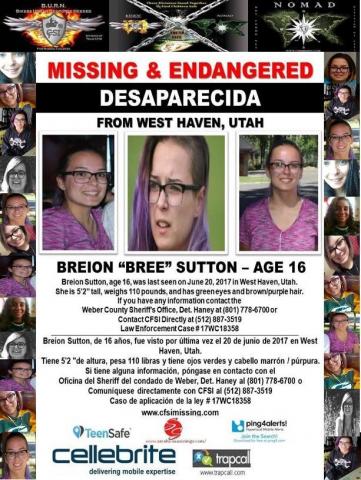



Deadline to Enroll in Agriculture Risk Coverage (ARC) and Price Loss Coverage (PLC)
Utah Producers Have until Aug. 1 to Enroll in ARC/PLC
SALT LAKE CITY, Utah, July 17, 2017 – U.S. Department of Agriculture (USDA) Utah Farm Service Agency (FSA) Acting State Executive Director (SED) Jeanine Cook reminds farmers and ranchers that they have until Aug. 1 to enroll in Agriculture Risk Coverage (ARC) and/or Price Loss Coverage (PLC) programs for the 2017 crop year. These programs trigger financial protections for participating agricultural producers when market forces cause substantial drops in crop prices or revenues.
“Producers have already elected ARC or PLC, but to receive program benefits they must enroll for the 2017 crop year by signing a contract before the Aug. 1 deadline,” said Cook. “Please contact your local FSA office to schedule an appointment if you have not yet enrolled.”
Covered commodities under the programs include barley, canola, large and small chickpeas, corn, crambe, flaxseed, grain sorghum, lentils, mustard seed, oats, peanuts, dry peas, rapeseed, long grain rice, medium grain rice (which includes short grain and sweet rice), safflower seed, sesame, soybeans, sunflower seed and wheat.
For more program information, contact your local FSA office or visit www.fsa.usda.gov/arc-plc. To find your local FSA office, visit http://offices.usda.gov.
#
USDA is an equal opportunity lender, provider and employer.
========================
SALT LAKE CITY , UT, USA , July 17, 2017 /EINPresswire.com/ -- Many patients with melanoma need a sentinel-lymph-node biopsy to determine if cancer cells have spread there, but a positive finding doesn’t mean all the lymph nodes in the area must be removed, according to a new international study conducted in part by researchers in Utah that may change standard treatment for melanoma patients whose cancer has spread.
The international study involving 63 centers, including Intermountain Healthcare's Intermountain Medical Center and the Huntsman Cancer Institute in Salt Lake City, involving more than 3,500 patients, suggests any survival advantage associated with removing all the lymph nodes in the area closest to the melanoma is too small to justify the complications patients may suffer from having them removed.
Approximately one-fourth of the patients in the randomized phase-three trial were treated for melanoma at Intermountain Medical Center or the Huntsman Cancer Institute.
Findings from the study were published in The New England Journal of Medicine.
Melanoma is a comparatively rare but potentially deadly form of skin cancer. Although it makes up fewer than one percent of all skins cancers, melanoma is responsible for most skin cancer deaths, according to the American Cancer Society. Roughly 87,000 new cases of invasive melanoma are diagnosed in the United States each year.
Lymph nodes are small glands that carry fluids, nutrients, and waste between tissue and the bloodstream. The lymphatic system plays a key role in the body’s immune response to infection and disease.
Because melanoma can spread to the lymph nodes, a routine step in treatment often involves removing the closest draining lymph node, called the sentinel node, and checking it for melanoma cells. For melanoma on an arm, for example, that nearest lymph node would be in the armpit, while the nearest lymph node for melanoma on the foot would be in the groin.
When a biopsy detects melanoma in a sentinel node, standard treatment has been to remove all the nearby nodes, which sometimes triggers complications, said Tawnya L. Bowles, MD, one of the study authors, and principal site investigator at Intermountain Medical Center.
“It can be a very big deal for patients,” said Dr. Bowles. “They can have repeat hospitalizations for infections in their extremities. They can have life-limiting, painful swelling where they can’t do the activities they like to do or wear their usual clothing. It’s a significant, real problem for patients who are affected.”
The new study, called the Multicenter Selective Lymphadenectomy Trial II, enrolled 3,531 patients who had melanoma. Of those, 1,939 patients had an abnormal sentinel-node biopsy and were randomly assigned to one of two groups for further study and treatment.
One group received the standard of care and had all the lymph nodes in the area removed. The other group had ultrasounds of the remaining lymph nodes instead of more surgery. For the first two years, they had ultrasounds every four months, followed by ultrasounds every six months out to five years. Two years and five years are significant time points for recurrence, Dr. Bowles said.
In the ultrasound group, if the lymph node got bigger or other abnormalities were detected, a needle biopsy was done to look for melanoma. If it was detected, the other lymph nodes were removed. If the ultrasound was normal over the study period, patients kept all but their sentinel lymph nodes and didn’t have more surgery.
The survival rates of the two groups were compared to see if patients who had multiple lymph nodes removed were more likely to be alive three years later compared to those who kept them.
The study found no significant difference in melanoma-specific survival at three years. But for patients who had those lymph nodes removed, the risk of swelling in the affected arm or leg was four times greater compared to whose lymph nodes were intact.
Some in the group whose lymph nodes were left in place had a recurrence in their lymph nodes. When melanoma recurred in a lymph node, the patients were treated and mortality didn’t significantly increase during the study.
Removing the sentinel lymph node for biopsy is of major importance, according to the study authors.
“If the sentinel-node biopsy hadn’t been done, the tumor present in the lymph node would have grown and progressed,” said Dr. Bowles. “Checking that lymph node is really important, but many patients can be spared taking out the others.”
The study raises another question that’s yet to be sorted out. With melanoma, immune therapy is often given as an added, or adjuvant, treatment. But most studies of adjuvant therapy have been done in patients who had all their lymph nodes removed after an abnormal sentinel-lymph-node biopsy. That means researchers know how well the therapies work in those patients, but not whether immune therapy results would change if the nodes remain in place. The treatment could be just as effective, but isn’t yet proven in clinical studies.
“The question of immune therapy is important, because while removing lymph nodes eliminates the risk that melanoma will spread there, it doesn’t stop melanoma from spreading to organs, bones, and distant lymph nodes,” Dr. Bowles said. “Patients who die typically die of those distant metastases.”
This isn’t the first time that spread of cancer through lymph nodes has been studied. Similar findings regarding treatment when breast cancer spreads to lymph nodes have already changed the standard of care for those patients. A positive sentinel node biopsy no longer automatically means all lymph nodes in the area will be removed.
Dr. Bowles hopes that will be the case with melanoma.
“I hope dermatologists and other healthcare professionals who treat melanoma will understand the sentinel node biopsy is still important, but not all patients need to have follow-up surgery to remove all the other nodes if that sentinel node is positive for melanoma,” she said.
Intermountain Healthcare researchers plan to follow the study-enrolled patients in their clinic, looking for 10-year survival and recurrence rates.
“Because we have a large group of patients who were in the ultrasound group, we hope to learn more about their outcomes. Did they have immune treatment? How did they do over time?” Dr. Bowles said. “We’re looking forward to continued insights and more advancements in the standard of care for melanoma patients.”
==========================
Three Americans every minute call the poison control center because they have make a medication error. Four out of 10 mistakes involved painkillers, hormone therapy prescriptions or heart medication. The rate of medication errors rose from 1.09 for every 100,000 Americans in 2000 to 2.28 per 100,000 by 2012. Nationwide around 1.5 million medication errors occur every year.
Below is a link to more information on how medication mistakes are causing more Americans to call the poison control center.
The TimerCap is currently being used to help reduce medication errors among patients worldwide. The TimerCap is currently being sold at every CVS and Rite Aid Pharmacies worldwide.
Here are just four very recent news coverage on how CVS is using the TimerCaps to fight opioid addiction and promote prevention. Here is the link to over 300 news coverage.
==========================
DENVER, CO—The Center for Western Priorities’ Monuments to America six-state RV road tour will launch on Monday, bringing together business leaders, outdoor advocates and local elected officials who will urge President Donald Trump and Interior Secretary Ryan Zinke to stop the assault on popular national monuments that boost local economies.
WHAT:
Six-state tour urging President Trump and Secretary Zinke to stop the attack on national monuments. Business leaders, outdoor advocates, and elected officials will discuss how national monuments and other protected public lands help create jobs, support the local economy and define the West’s outdoor way of life.
TOUR SCHEDULE:
Grand Junction, Colorado
Monday, July 17th at 10:00am
Las Colonias Park Amphitheater, 925 Struthers Avenue
Albuquerque, New Mexico
Tuesday, July 18th at 10:00am
Tiguex Park, 1800 Mountain Road NW
Flagstaff, Arizona
Wednesday, July 19th at 10:00am
Flagstaff City Hall, 211 W Aspen Avenue
Palm Springs, California
Thursday, July 20th at 10:00am
Whitewater Preserve, 9160 Whitewater Canyon Road
Las Vegas, Nevada
Friday, July 21st at 9:45am
Springs Preserve, 333 S Valley View Boulevard
Salt Lake City, Utah
Saturday, July 22nd at 10:00am
Patagonia Outlet, 2292 S Highland Drive
VISUALS:
Wrapped Monuments to America tour RV; oversized inflatable Statue of Liberty.
VIDEO & AUDIO:
Broadcast quality video and audio of the press conference from each stop will be available online following the events at bit.ly/monumentsmedia.
BACKGROUND
In late April, President Trump issued an executive order instructing the Department of the Interior to review 27 national monuments protected over the last 21 years. The national monuments under review are home to treasured archaeological sites, awe-inspiring pristine landscapes, and open spaces for hiking, fishing and camping. Every indication from President Trump, Interior Secretary Ryan Zinke and politicians close to them is that the outcome is preordained and the review will lead to attempts to shrink or eliminate national monuments. Rolling back national monument protections through executive action is an unprecedented, and likely illegal, move that puts all of America’s protected lands, parks, forests and monuments at risk.
The Center for Western Priorities recently conducted an analysis of public comments submitted to the Department of Interior and found 98 percent expressed support for keeping or expanding the national monument under review.
The Center for Western Priorities’ Monuments to America tour is a six-state RV road-trip highlighting national monuments across the West that are threatened by President Trump’s executive order. The tour—featuring a wrapped RV and oversized inflatable State of Liberty—will conclude at the final Outdoor Retailer trade show in Salt Lake City. Outdoor Retailer is leaving Salt Lake City for Denver after 20 years in protest of Utah politicians’ anti-public lands agenda.
This spring, the Center for Western Priorities launched a multi-state ad campaign encouraging national leaders to respect the heritage and history of America’s national monuments.
For more information, visit westernpriorities.org. To speak with an expert on public lands, contact Aaron Weiss at 720-369-9252 or aaron@westernpriorities.org.
=========================
Dawn McQueeney
615-546-9478
MISSING CHILD MISSING ONE MONTH PRESS RELEASE
West Haven, Utah – The Center for Search & Investigations for Missing Children is seeking public assistance in locating Breion Sutton, a 16-year-old female, who was reported missing a month ago. Sutton was last seen on Tuesday June 20, 2017 in West Haven Utah.
Sutton is described as 5' 2” and weighs 110 pounds, with brown/purple hair and green eyes. She also has both ears pierced and wear glasses. She is a beloved daughter and friends and family members are pleading with the public to help bring her home.
The Center for Search & Investigations (CFSI) assists families and communities in facilitating the search and location of missing children nationwide in order to safeguard children from abduction, human trafficking & exploitation. The Center for Search & Investigations is a 501c3 Non-profit organization.
If anyone has information leading to ’s location, please contact: Detective Haney (Weber County Sheriff’s Office) at (801)-778-6700, CFSI Directly at (512) 887 -3519, or dawntnburnersec@gmail.com
press release regarding a missing teen girl from West Haven, Utah. She's been missing now for a month. As you may or may not know, human trafficking is a very big concern, and a growing epidemic, in Utah and all around the United States. CFSI is assisting the family of this young girl with the search and location to bring her home safely. As members of the media, your assistance is needed.
Someone, somewhere, has seen her. They just may not know that she is missing. Thank you so much